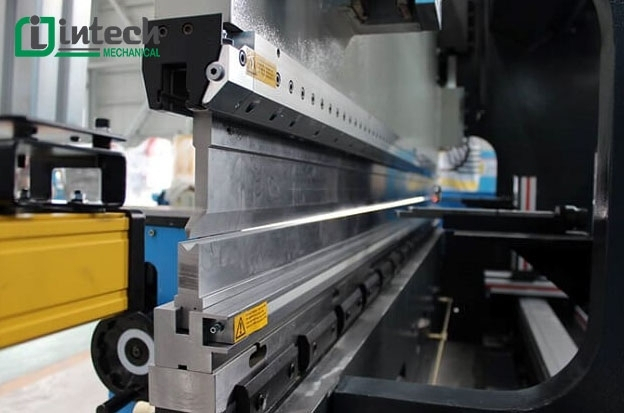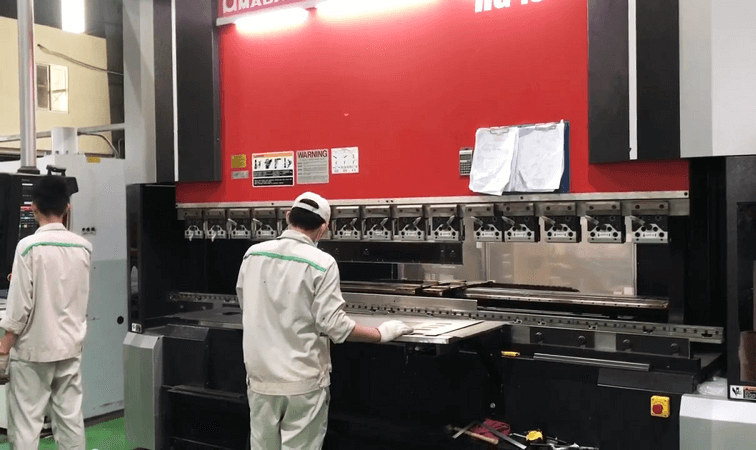Mục lục
Sheet metal is a core material in every industry, from home appliances to automobiles. However, its value is only exploited when it is shaped into parts with precise shapes and angles. This is where bending and stamping plays a key role.
Bending and stamping is a key process, using force to transform flat sheets into parts with angles (L, U, Z, etc.) according to design requirements. This process requires not only physical bending but also high precision. The advent of CNC bending and stamping technology has revolutionized this method, ensuring perfect assembly and final product quality.
Bending and stamping is a key process, using force to transform flat sheets into parts with angles (L, U, Z, etc.) according to design requirements. This process requires not only physical bending but also high precision. The advent of CNC bending and stamping technology has revolutionized this method, ensuring perfect assembly and final product quality.
What is bending and stamping?
Bending and stamping is a method of forming metal sheets by using force to bend, fold or shape the metal sheet according to the required angle, shape and size. This process uses a specialized, modern press brake with CNC technology to create precise metal parts
- The important role of bending:
Sheet metal bending is popular because of the following advantages:
- Increased structural strength: Creating corners and edges helps to disperse stress and increase the rigidity of thin metal sheets, helping them withstand loads better.
- Reduced assembly costs: Allows the creation of a multi-faceted part from just one metal sheet, reducing the need to weld or assemble multiple parts together.
- High accuracy: Especially when using a CNC press brake, the process ensures high repeatability, which is very important in mass production.

Traditional bending processing method
Before CNC bending machines became popular, sheet metal forming was mainly performed on traditional bending machines:
Main equipment: Hydraulic bending machines or old mechanical bending machines, operated by liquid or mechanical pressure. These machines often have simple control systems, few axes (Axis) and almost no automatic compensation for material errors.
Basic bending types: In terms of bending techniques, they still perform basic bending types such as: V-bending (creating sharp, obtuse angles), Edge Bending (90-degree folding), and U-bending (creating grooves).
- Core disadvantages of traditional bending:
Although the traditional method is still useful for simple jobs, it exposes many major limitations for modern industrial production:
- Slow speed and low productivity: The process of setting up the machine (set-up), changing the mold and aligning must be done manually, causing costly downtime.
- Accuracy depends entirely on skill: Spring-back phenomenon requires workers to have deep experience to test, measure and adjust the pressure or depth of the punch after each bend. This makes the consistency between products not high, especially with large batches.
- Difficult to handle difficult materials: With materials with high elastic limit such as thick stainless steel, manual adjustment becomes more complicated and easily causes waste.
CNC Punching: The revolution of precision
CNC Punching is a technology that uses a punching machine that is completely controlled by a computer numerical programming system (Computer Numerical Control). This is a huge step forward compared to traditional punching machines, completely solving problems of speed and precision.
- Core Differences:
| Features | Traditional Press Brakes | Modern CNC Press Brakes |
| Control system | Simple Manual/Hydraulic | Digital Programming, Touch Screen Interface |
| Axis Few | Axis (usually 2) | Multi-Axis (from 4 to 12 axes, e.g. Y1,Y2,X,R,Z1,Z2) |
| Accuracy | Depends on workmanship, error ±0.5 mm | Very high, error almost absolute (±0.01 mm) |
| Error Compensation | Manual (adjust material, pressure) | Automatic, hydraulic/mechanical compensation system (Bombing Compensation) |
| Speed & Setup | Slow, time-consuming setup | Fast, program setup in just a few minutes |
5 Golden advantages of CNC press brakes
CNC Press Brakes technology has become the mandatory standard for all high-quality sheet metal products, thanks to 5 outstanding advantages after:
- High precision and uniformity:
This is the most important factor. Thanks to the multi-axis numerical control system and the automatic Springback Compensation feature, CNC machines can achieve almost absolute precision, typically ±0.01 mm for bending angles. This ensures that all parts in a batch, whether 1 or 1000 products, are of consistent quality, completely eliminating dependence on worker skills.
- Superior speed and productivity:
CNC machines significantly shorten setup times. The bending program is simulated and stored in advance, making the process of changing from one product to another only a few minutes. The moving speed of the punch is also faster, thereby reducing production cycle times and increasing overall productivity.
- Capability to handle complex bending angles:
The diverse rear axle system (from 4 to 12 axes) allows the machine to position the workpiece at many different positions and angles. This helps to perform parts with complex shapes, overlapping bending angles or requiring multiple consecutive bending on the same workpiece that traditional machines cannot do.
- Material savings and reduced waste:
With high precision right from the first punch, CNC machines minimize errors and material waste. 3D simulation on software before actual machining also helps detect and eliminate design errors or process errors (such as mold collisions, wrong bending order) right on the computer, helping to save production costs.
- Maximum labor safety:
Modern CNC bending machines are equipped with a laser sensor safety system. This system automatically stops the machine immediately when detecting an object (e.g., human hand) entering the work area, minimizing the risk of accidents, while reducing direct intervention by the operator.

4-step process of performing standard CNC bending machining
The bending machining process using CNC machines is standardized and highly automated, helping to eliminate manual errors and optimize production time.
Step 1: 3D Design and Development
- The engineer designs the product details on 3D software (SolidWorks, Inventor, etc.).
- Then, the 3D part is unfolded into a 2D flat plate. This process accurately calculates the material expansion coefficient (K-Factor) and the bending allowance length (Bend Allowance) to ensure that the part after bending reaches the standard size.
Step 2: Programming and setting up the mold
- The bending program is programmed directly on the CNC control system (or imported from offline software).
- The engineer determines: the bending order (to avoid mold collision), bending angle, required pressure, and the position of the back gauge.
- Select and mount the punch and die to match the required bending radius and angle. The CNC system automatically recognizes and checks the mold's suitability.
Step 3: Material mounting and automatic operation
- The operator places the cut metal sheet (blank) in the bending position.
- The back gauge system automatically adjusts to the programmed position.
- The automatic bending machine automatically performs a series of bending steps according to the program. The Bombing Compensation system is activated in real time to ensure the bending angle reaches maximum accuracy without the need for manual adjustment by the operator.
Step 4: Quality control and finishing
- The part after bending is checked for quality with specialized tools (angle gauge, electronic caliper).
- Thanks to CNC technology, the scrap rate is very low. After reaching the standard, the product is transferred to the next stage such as welding, grinding, or finishing paint.
Commonly used sheet metals in bending processing
Sheet metal is a metal material rolled into thin sheets, usually with a thickness of 0.5 mm to 20 mm (depending on standards and industry). This is an essential input material in machine manufacturing, construction and equipment production.
- Common materials:
- Stainless steel: Includes grades such as Inox 304, 201, 316. This material has high durability, corrosion resistance and hygiene, and is often bent to make industrial kitchen equipment, food machine housings, or architectural facades.
- Carbon steel (Black steel): Structural steels such as SS400 or A36 are economical choices for frame details and industrial machine housings. Usually galvanized or powder coated after bending.
- Galvanized Steel: Has a protective zinc layer on the outside, effectively prevents rust, very popular in the manufacture of electrical cabinets, cable trays, and ventilation systems.
- Aluminum: Lightweight material, good heat conductor, and has natural corrosion resistance, often used in the automotive, aviation, and decoration industries.
- Important requirements for bending materials
For the bending process to be successful and create precise details, the material must meet the technical criteria:
- Flexibility: This is a key factor, determining the ability of the metal to be bent under pressure without cracking, tearing or breaking. Materials with high ductility help minimize the risk of damage during processing.
- Thickness: Thickness not only affects the bending force (machine capacity) but also determines the minimum bending radius that can be achieved. The thicker the material, the more powerful the machine is required and the larger the bending radius must be to avoid cracking the material.
- Elastic limit: The stiffness of the material determines the degree of "springback" phenomenon - that is, the tendency of the material to bounce back a small angle after the pressing force is released. Modern CNC bending machines must have a precise compensation system to control and eliminate this phenomenon, ensuring the bending angle meets the standard.
Applications of sheet metal bending processing
Here are the typical applications of this processing method:
1. Construction and architecture industry
- Structures and Support Frames: Bending to create L-shaped, U-shaped, Z-shaped bars as load-bearing frames, purlins, or connecting details in steel structures.
- Roof and Gutter Systems: Processing roofing panels, gutters, and roof edging details (flashing) with complex folding angles to ensure drainage and waterproofing.
- Architectural decoration: Wall panels, ceiling panels, doors, metal railings with sharp, sophisticated folding lines.
2. Mechanical engineering and manufacturing industry
- Enclosures: Folding to create protective covers for industrial machinery, electrical cabinets, tool boxes, and automation equipment.
- Brackets and Braces: Manufacturing of brackets, bases, and braces with precise bending angles, used to assemble parts in machinery.
- Machine parts: Components inside machinery and production equipment that require high precision in angle and size.
3. Automotive, aviation, and transportation industry
- Automotive components: Manufacturing of body parts, chassis, door panels, hoods, and interior parts of vehicles with high durability and precision requirements.
- Aerospace: Manufacturing fuselage parts and other parts that require lightweight materials but absolute rigidity, often using folding techniques with aluminum or titanium materials.
4. Electronics and telecommunications industry
- Electronic equipment enclosures: Manufacturing computer enclosures, network equipment enclosures, server cases, and telecommunications components that require high levels of tightness and protection.
- Internal components: Electromagnetic shielding plates and rails for mounting components inside the device.
5. Household appliances and furniture
- Household appliances: Refrigerator enclosures, washing machines, range hoods, ovens, where metal sheets are required to be folded and shaped into cubes.
- Metal furniture: Table legs, chair frames, filing cabinets, decorative shelves with curved or angled lines to increase aesthetics and strength.
Intech Mechanics: Perfect CNC bending and stamping solutions
Sheet metal bending and stamping is an indispensable forming process, the foundation for transforming flat materials into functional and aesthetic structures in all industries. In particular, with the development of CNC Punching, the accuracy, speed and uniformity of the product have been raised to a new level, meeting the most stringent technical standards today.
If you are looking for a reputable and quality punching partner, Intech Mechanical is a reliable choice. The reason to choose Intech is because we own a modern CNC punching system, a team of experienced engineers, ensuring the ability to process from simple details to complex products with absolute precision, committed to progress and consistent quality on every shipment.
To receive detailed advice and quotation for punching, please contact:
- Hotline: 0966 966 025
- Address: Lot 6, Lai Xa Industrial Cluster, Tay Tuu Ward, Hanoi City





